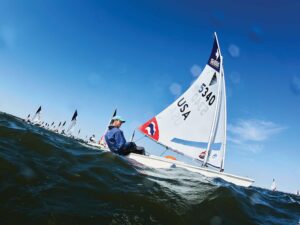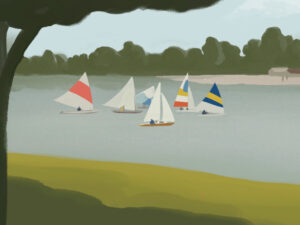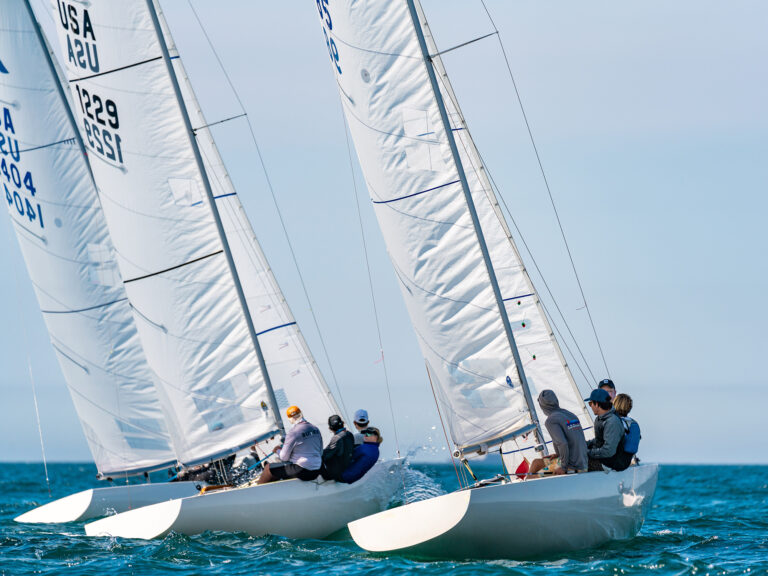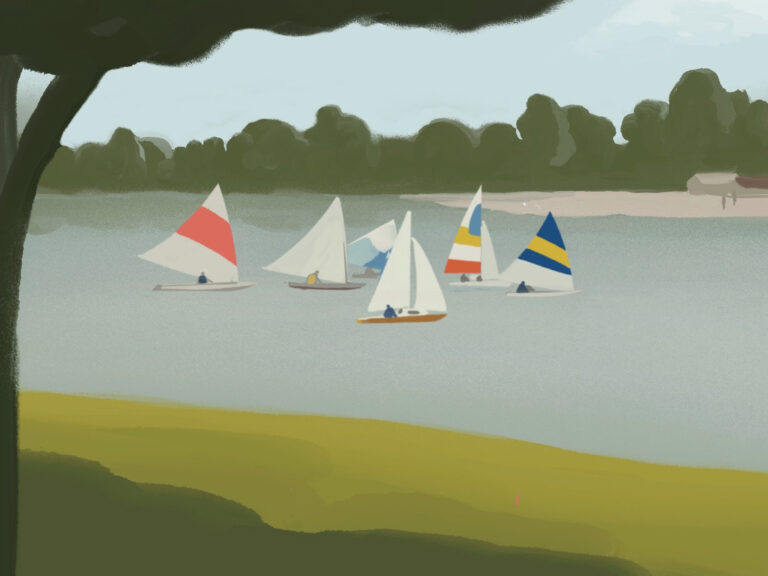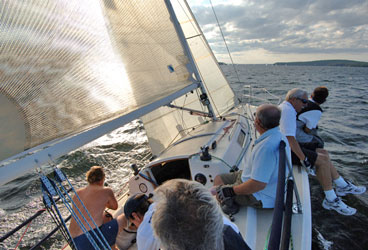
Lake Champlain
Dana Point YC
Dana Point, Calif.
During the summer, we have two races on Thursday, one at 2 p.m. with a pursuit start so we all get back to the club around the same time. That runs year round. During the summer, we add a 6 p.m. race.
My racing buddy, Tom Patty, and I own an old Cal 2-27 and we raced in the afternoon race. July 29 was beautiful, with perfect wind. We came in second place, about a half second behind a Catalina 30.
I sometimes refer to the 2 p.m. race as “The Race for Second Place,” because the winner is responsible for calling the course and countdown the following week.
After a glass of wine at the club, I went out to take some video clips of the evening race.
First I drove to the top of the cliff overlooking the course and shot the boats rounding the windward mark we call the whistle buoy. Then I went back down to the harbor and hiked out on the rocky jetty. I was lucky to get some shots of the boats tacking up the mile long channel to the finish in front of the club.
Mark Downey on OrrSki was the first boat to finish in his class. Mark’s good friend, Steve Orr, passed away unexpectedly a few years ago, and Mark purchased the Capo 26 from Steve’s widow. We use to call Steve “Mr. Beer Can” because he always finished in the top of his class. Mark has kept alive Steve’s legacy.
—Bill Taylor
Davis Island YC
Tampa, Fla.
Clusters of gray cumulus clouds were scattered east of Hillsborough Bay by early afternoon and the flags at the Davis Island YC were barely stirring. It was a typical summer afternoon, the heat of the day building into afternoon clouds that often expunge their power as thunderstorms. The shifting storm pressure often induces high winds, which make for exciting Thursday night race series action.
The threatening clouds out of the east unfortunately backed off and the result was a lull at the start, boats in most classes easing across the start line without the usual jostling. Sailing aboard Wing It, a 41-foot Irwin in the racer/cruiser fleet, I watched the other classes—Melges, J24, Spinnaker A, and Spinnaker B—start and coast into the course.
A decent wind eventually crept up midway through the race, enough for boats to fly chutes. There was a lot of chatter and shouting on the course as the smaller boast sailed straight into the larger spinnaker fleets.
The dense skies lifted, revealing a fireball sun sinking toward the horizon as we finished the race, crossing the entrance line into the Davis Island Seaplane Basin where the fleet is docked. In the basin, masts rocked and swayed, silhouetted in the pink sky.
—Joseph Gamble
Davis Island YC
Tampa, Fla.
“Crew looking for boat!” announces the bartender over the loudspeakers.
“Two crew looking for boat.” A skipper steps up to claim both young men.
A few minutes later the call goes out, “Boat looking for crew!” Soon all the matches are made, and the fleet of 40 cruises out of the basin to greet the 4-knot southeasterly. The air and water temperatures both hover around 90. The eight racing divisions include everything from a Laser to a Farr 395.
The centerboards start first, led by a 470 and a Fireball, followed five minutes later by Spinnaker A. Aboard Bob Glaser’s J/105 Orangutan, we start a few seconds late at the starboard end, but we head left as the breeze veers right. As we poke our bow into the ship channel in the left corner, a tanker sounds his horn. Fortunately, our main trimmer is a harbor pilot, so he radios his fellow pilot that we will tack away long before the tanker blows past.
We are still mid-fleet at the weather mark. The veering wind turns the run into a beam reach. Next we turn right around a tall range structure and close reach back to the leeward mark. Using both helm and voice, the bigger boats negotiate their way through the later classes as we round the same mark in different directions, and head for the finish in front of the clubhouse. George Cussins’ J/105 Fire & Ice was the first boat to tack to the right off the line, and corrects to first in our division. Orangutan slogs into sixth place, but still ahead of two others. And the beer is cold, the rum & cokes quite tasty. Just another wonderful evening in paradise.
—Eric Robbins
J/80 Fleet 1
Lake Winnipesaukee, N.H.
The wind blew from the northwest at 15 to 20 mph, with some higher gusts. Boathandling was a challenge. In the second race, we had some trouble setting the spinnaker, wrapping it so badly we had to retire without sailing the run. Planning downwind on a big mountain lake is something everyone should experience
One of our regular crew on Over the Edge drives up from Concord, N.H., which is about a half hour south. Some Thursdays at 3:30 p.m., it looks like there is going to be no wind or it will be cloudy or raining. He wonders whether the ride will be worth it. But he always drives home with a smile on his face.
—Tom Dunfee
Rochester YC
Lake Ontario, N.Y.
The plan was to race on the Ideal I8 Blonde Ambition with my mentor Jon Faudree. He has taught me so much about sailing as well as life, I was tremendously nervous that I would not meet his expectations. I’d never sailed an Ideal 18 nor flown a chute.
We rigged the boat and Jon taught me the function of each line. I helped him prepare the lifting bridal and push the boat over to the hoist.
When we got the boat in the water, I raised the main, and then unwrapped the jib.
When the murky, brown water of the Genesee River transformed into the cold blue water of Lake Ontario, my nerves turned into adrenaline. We were ready to sail, and I was ready to learn. Jon then told me to raise the kite for practice. I was extremely happy that I was going to try it out before the race. Well, of course, my first mishap of the night occurred. There was a twist in the sail. Jon responded with a shrug and a laugh. Relief flowed over me when I realized that I had just clipped the sail on wrong.
The horn for the first race sounded. This start was more chaotic than any I have ever seen. I heard knock, lift, puff, and lull all being yelled at the same time. Upwind it was smooth sailing. Downwind also was fairly smooth, except I wasn’t quite sure why the spinnaker pole would not remain clipped to the guy. We soon realized it was broken.
For our second race, we had no spinnaker pole. That hindered our speed a bit. But at least this wasn’t my fault.
For the last race, we had three general recalls. It went from annoying, to aggravating, to infuriating. During the race, I was able to fix with the spinnaker pole. After we hoisted the spinnaker, Jon told me to coil the line so it would run freely when we took the spinnaker down. Unfortunately, my coil turned into a bit knot, and I couldn’t get the knot out. Jon told me to take the tiller. It was the moment I’d been waiting for. I was now the skipper of the ideal 18 Blonde Ambition. We didn’t win, but that didn’t matter to me. I was skippering on a Thursday night. Perfect.
—Charlie Siragusa
Malletts Bay Boat Club
Lake Champlain, Vt.
I hitched a ride on a friend’s J/92. The weather was perfect, 12 to 18 knots, with blue skies and puffy white clouds.
Being in A class, we started last. Just before the gun, we were pushed over the line. We luffed the sails to slow down, bore away, jibed, dipped the line, and restarted. Luckily the wind had shifted right, so we sailed on port for a short distance then tacked to starboard and had everyone by the time we rounded the upwind mark.
The race was a breeze, pardon the pun, twice around a windward-leeward course. The asymmetric spinnaker on the J/92 makes downwind sailing really easy. We heeled the boat to windward to project the kite away from the main. It worked great, and we ended up winning the whole race by a few seconds.
After the finish we sailed toward the lakeside house of one of the crew. When we got close enough, he jumped off and swam home. Then we had a few beers and watched the sun set.
—Paul O. Boisvert
Jubilee YC
Beverly Harbor, Mass.
“Are you going to respect that mark?” came the hail from the big Sabre.
“Actually,” we replied, “we’re going to round that mark.”
When 40 boats in six fleets sail one of two different courses from the same starting line using only government marks, strange things can happen. The A-Fleet Sabre started 15 minutes before our C-Fleet S2 7.9, Maniac, but its longer course put us even on the second downwind leg. We were both broad reaching on starboard, overlapped, with the Sabre to windward and needing to leave the green can to starboard. We had right of way and needed to round the same green can, but to port. With the mark quickly approaching, the Sabre was forced to do the only thing they could: slow down in order to fall clear astern, jibe behind us, and then head up hard to leave the can to starboard.
Weeknight racing at Jubilee YC is both quirky and competitive. Although the club tries to run windward leeward races, the wind doesn’t always cooperate with the fixed-mark courses. July 29 featured our third downwind start of the year. It was the first of the 10-race summer series. The spring series had come down to the last race, with three boats virtually tied for the lead after nine races. We had tanked that final race, but this night luck was with us and we won, ahead of our fiercest rival and closest friends on Peregrine, another S2 7.9 and winner of the spring series.
As at many clubs, the racing is only half the fun. A playlist specifically created for wins accompanied our sail back into the harbor. As we do after each race, we awarded a double-sized beer to the evening’s most valuable crew. The Peregrine crew joined us on Maniac, and we recounted the race in detail as the cloudless twilight faded into night. Eventually back at the clubhouse, we listened to the results and then hung out on the deck, chatting with the other crews, laughing at our mishaps, watching the rising moon reflecting off the harbor, unwilling to let the evening end, but anxiously looking forward to doing it again in a week’s time.
—Roger Kuebel
Svendsen’s Marine Thursday Night Series
San Francisco
While standing at the Treasure Island Sailing Center dock and assessing the building breeze and rapidly approaching fog bank, I made suggestion to John Super Sr., the PRO for the Thursday Night Laser and Vanguard 15 series: “How about we finish some races at the weather mark and then for the next race have a downwind start from top of the course?” In less than a minute we had a plan. I then spread the word throughout the parking lot; my answer to why we were going to have downwind starts tonight was simple: “Why not?”
From there, the evening was a windy blur. John Super Sr. and his son, John Super Jr., managed five races for each fleet. The good news: we won two of the races. The bad news: the air was 52 degrees, the winds 15 to 25 knots, and the fog was on. Halfway up the final leg of Race 3, I did a Jacques Cousteau imitation off the rail when my hiking strap untied. The last things to get wet were my ankles. I surfaced to my crew Avery Patton giving me the “Seriously?” look. In Races 1 and 4, I barreled into significant turning mark fouls, prompting Avery to give me another look. This one said, “How many years have we been doing this?”
Each week, one or two teams volunteer to host everyone’s post-race beers and appetizers. This week the Laser Fleet all chipped in and we headed to the only bar on Treasure Island for some warm shelter and wet beverages. Our shivering bodies thawed and the stories flowed, another epic Thursday night in the books.
—Matt Sessions
J/24 Fleet 50
Newport, R.I.
On the final leg of a Thursday evening J/24 race on Narragansett Bay, it’s not unusual to see four sailors on deck focusing on the fastest path to the finish and one prairie-dogging out of the companionway, engine in hand. Each finish horn is followed quickly by the tinny rumble of a small, usually poorly maintained, two-stroke sparking to life and being throttled up. This race after the race—the finish line is the Sail Newport hoist dock and the Racing Rules of Sailing do not apply—is often as hotly contested as those that go on the scoresheet.
Being among the first boats to Sail Newport’s Admiral’s Pier on a Thursday evening means a timely hoist, leaving plenty of time for casually finishing whatever’s left in the cooler, socializing with other sailors, and facetiously sympathizing with those still waiting for their turn at the crane.
I know this informal race well, which is why I’m so thankful that I no longer take part. Ian Scott keeps the Crack of Noon in a prime slip at Newport YC (one of many fruits of a lifetime spent on Aquidneck Island). So on July 29th, while every other team crossed the line, dropped its jib, and fired up the kicker, the Crack of Noon team opened a fresh round of beers, rehashed the race (a disappointing 11th marred by a rash decision to split from the fleet on the run), and did our usual harbor cruise along the Newport waterfront. By the time we turned our attention toward the slip, the sun was a memory and so was the breeze.
A sympathetic launch driver offered us a hip tow for the final 200 yards. We spun the boat around, backed it into the slip, and set about rolling up the sails in the dark. The hoist across the harbor had long since stopped cranking. The handful of J/24s that stay in the water were all bobbing quietly on their moorings. It’s the same every Thursday. When it comes to the race to port, we finish last, and not by a small margin. I wouldn’t want it any other way.
—Stuart Streuli
Up Next: One Saturday in America
Third time’s the charm, right? Let’s mix things up and pick a weekend day. We’d like to hear about your sailing adventures—win, lose, or rained-out—from Saturday, July 16. Photos and/or stories are welcome. For more information on how to contribute, SailingWorld.com/1106Saturday


